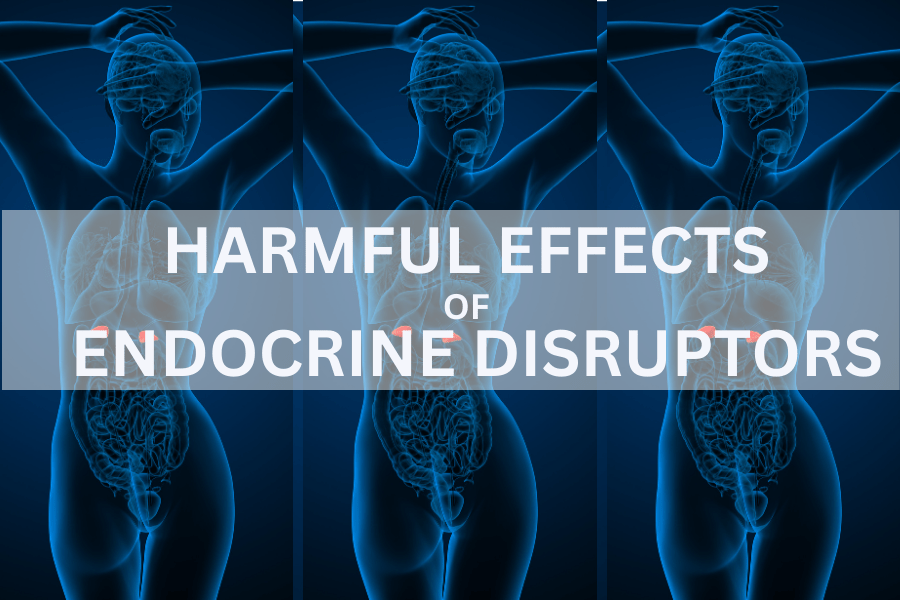Understanding Endocrine Disruptors and Their Impact on Women’s Health
Endocrine disruptors are chemicals that can interfere with the endocrine (or hormonal) systems. These disruptions can cause a host of harmful symptoms and disorders. Here, we’ll explore some key endocrine disruptors and how they specifically harm the female body.
What Are Endocrine Disruptors?
Endocrine disruptors can be found in many everyday products, such as:
- Pesticides (e.g., DDT, glyphosate)
- Industrial chemicals (e.g., PCBs, BPA, phthalates)
- Plastic additives (e.g., DEHP)
- Consumer products (e.g., cosmetics, detergents)
- Herbicides (e.g., atrazine)

How Do They Harm the Female Body?
1. Disruption of Menstrual Cycles and Hormonal Balance
Endocrine disruptors can mimic or interfere with the body’s hormones, leading to irregular menstrual cycles and imbalanced hormone levels. This disruption can manifest as severe PMS, heavy or irregular periods, and other menstrual disorders.
Hormonal Imbalance and Its Impact on the Menstrual Cycle
The delicate balance of hormones in the female body, including estrogen and progesterone, orchestrates the menstrual cycle with precise timing. However, when endocrine disruptors interfere, this balance can be thrown into disarray, leading to a cascade of health challenges. Hormonal imbalance often results in unpredictable cycle lengths, heavy bleeding, or even skipped periods. Furthermore, women may experience exacerbated symptoms of premenstrual syndrome (PMS), such as mood swings, fatigue, and bloating. Over time, chronic disruption in hormonal balance can contribute to more severe reproductive health issues such as polycystic ovary syndrome (PCOS) and fertility problems. Understanding and addressing the impact of these disruptors is crucial for empowerment and the pursuit of a more harmonious connection with our natural cycles, driving us to make conscious choices towards healthier lifestyles and environments.

2. Increased Risk of Reproductive Health Issues
Exposure to these harmful chemicals has been linked to an increased risk of infertility and miscarriages. The chemicals can affect the ovaries, fallopian tubes, and uterus, leading to complications in ovulation, fertilization, and implantation.
Hormonal imbalance caused by endocrine disruptors plays a significant role in escalating the risk of various reproductive health issues. These imbalances can impede the normal functioning of reproductive organs, making conception and maintaining a healthy pregnancy challenging. Disruptors like BPA and phthalates can alter estrogen and progesterone levels, vital hormones that regulate ovulation and prepare the uterine lining for pregnancy. Inconsistent levels of these hormones may lead to conditions like endometriosis or fibroids, which can compromise fertility. Additionally, hormonal irregularities can heighten the risk of ovulatory disorders such as polycystic ovary syndrome (PCOS), which is a leading cause of infertility. By understanding how these disruptors affect our intricate hormonal networks, we empower ourselves to make informed decisions that protect and foster reproductive health, urging us towards lifestyle choices and advocacy efforts that prioritize environmental consciousness and personal well-being.
3. Altered Mammary Gland Development and Breast Cancer Risk
Some endocrine disruptors can alter the development of mammary glands, increasing the risk of breast cancer. Chemicals such as BPA and phthalates have been implicated in promoting the growth of cancerous cells in breast tissue.
Hormonal Imbalance and Its Contribution to Breast Cancer Risk
The intricate dance of hormones within the female body is paramount in maintaining not only reproductive health but also overall well-being. However, when endocrine disruptors invade this delicate system, the risk of developing breast cancer can increase significantly. These chemicals can mimic hormones like estrogen, binding to receptors and creating an overwhelming imbalance. Such disruptions in estrogen levels can stimulate breast tissue, potentially increasing cell proliferation that lays the groundwork for cancerous growths. The link between hormonal imbalance and breast cancer underscores the urgent need for awareness and action. By fostering a passionate commitment to reducing our exposure to these harmful substances, we empower ourselves to protect our health. This calls for an environmentally conscious approach that champions the reduction of harmful chemicals in our surroundings, advocating for healthier living conditions and regulations that hold manufacturers accountable for the safety of their products. Through collective efforts, we can strive towards a future where every woman feels empowered to live free from the shadows of this preventable risk.

4. Changes in Sexual Development and Early Onset of Puberty
Young girls exposed to endocrine disruptors might experience early onset of puberty due to the chemicals’ interference with normal hormone regulation. This can lead to long-term health consequences, including higher risks of hormone-related cancers.
Hormonal Imbalance and Its Effect on Early Puberty
The influence of endocrine disruptors extends deeply into the pubescent phase, where hormonal balance is crucial for normal development. When young girls are exposed to these chemicals, which mimic or interfere with natural hormones, they may encounter premature activation of their hormonal systems. This disruption can lead to early onset puberty, marked by earlier-than-average development of secondary sexual characteristics such as breast growth and menstruation. Beyond the physical changes, early puberty can have profound effects on emotional and psychological health, increasing risks for anxiety, depression, and social challenges. It also correlates with a higher likelihood of developing hormone-related health issues later in life, including increased risks of obesity and certain cancers. Recognizing the impact of these disruptors empowers guardians and communities to advocate for safer environments, promoting lifestyles that minimize exposure and support healthy developmental trajectories. By demanding stricter regulations and fostering environmentally conscious practices, we work towards protecting future generations and nurturing healthier societies.

5. Risk of Metabolic Disorders
There’s evidence that endocrine disruptors can contribute to metabolic disorders such as diabetes and obesity. These chemicals can interfere with insulin production and glucose metabolism, leading to an increased risk of type 2 diabetes and other metabolic issues.
Hormonal Imbalance and Its Role in Metabolic Disorders
The cascade of effects triggered by hormonal imbalances extends beyond reproductive health, infiltrating metabolic processes and predisposing individuals to disorders such as obesity and diabetes. Endocrine disruptors meddle with insulin regulation, crucial for maintaining blood sugar levels and metabolic homeostasis. Such interference can compromise the body’s ability to produce and respond to insulin effectively, paving the way for insulin resistance—a precursor to type 2 diabetes. Moreover, these disruptors may alter neurotransmitter and hormone levels involved in appetite regulation, leading to increased food intake and fat accumulation, contributing to obesity. This alliance between hormonal imbalance and metabolic disorders highlights the necessity for a vigilant and environmentally mindful approach. By embracing informed choices and advocating for reduced exposure to these hazardous chemicals, we empower ourselves to safeguard our metabolic health. Encouraging a shift towards natural, chemical-free products and sustainable living practices not only enhances personal well-being but also contributes positively to the global fight against metabolic disorder prevalence. Through shared responsibility and action, we can champion healthier, more balanced living environments for all.
6. Impacts on Thyroid Function and Hormonal Regulation
Endocrine disruptors can adversely affect thyroid function, leading to conditions such as hypothyroidism or hyperthyroidism. The thyroid gland is essential for metabolism, energy levels, and overall hormone balance. Disruption in its function can have widespread consequences on health.
Hormonal Imbalance and Thyroid Function
The thyroid gland serves as a critical conductor in the body’s hormonal symphony, regulating essential processes such as metabolism, energy production, and overall hormone balance. Endocrine disruptors pose a significant threat to this delicate system, interfering with the thyroid’s ability to produce and regulate hormones like thyroxine and triiodothyronine. Such disruptions can lead to conditions like hypothyroidism or hyperthyroidism, where the body’s metabolic rate is thrown off balance. Hypothyroidism, characterized by sluggish thyroid hormone production, may result in fatigue, weight gain, and depression. Conversely, hyperthyroidism, marked by excessive hormone release, can cause symptoms such as anxiety, weight loss, and an increased heart rate. The profound impact of hormonal imbalances on thyroid function underscores the importance of avoiding these harmful chemicals and promoting an environmentally conscious lifestyle. Empowering individuals through education and advocacy to reduce exposure to endocrine disruptors can safeguard thyroid health and support holistic well-being, fostering a more harmonious interaction between the environment and our bodies. By collectively striving for cleaner, safer practices, we create a legacy of health and balance for future generations.

What Can You Do?
Be Conscious of Product Choices
Opt for products labeled as “free from” specific harmful chemicals. Look for certifications and labels that denote eco-friendly and health-conscious products.
Support Eco-Friendly Practices
Encourage businesses and manufacturers to adopt safer, sustainable practices. Your buying power has a significant influence on market trends and production standards.
Stay Informed
Keep yourself updated about the latest research and developments regarding endocrine disruptors. Knowledge is power, and staying informed helps you make healthier choices for yourself and your loved ones.
Conclusion
Endocrine disruptors pose a significant threat to women’s health, impacting everything from menstrual cycles to reproductive health and beyond. By understanding the dangers and making informed choices, you can protect your health and advocate for a safer, healthier environment for everyone.
By following these guidelines, women can better safeguard their health against the pervasive threat of endocrine disruptors. Remember, small changes in daily habits can lead to significant improvements in health and well-being.
Ready to take the next step? Join our Grass Life Beauty community and get access to exclusive tips, eco-friendly product recommendations, and more. Together, we can make a difference. “Lets create a greener and more holistic approach to life” -Grass Life Beauty
If you enjoyed this article, don’t forget to share! Check out related post here.
I’m curious to hear about your thoughts on this topic. Please comment below and share so that we can create a more greener and holistic community.

